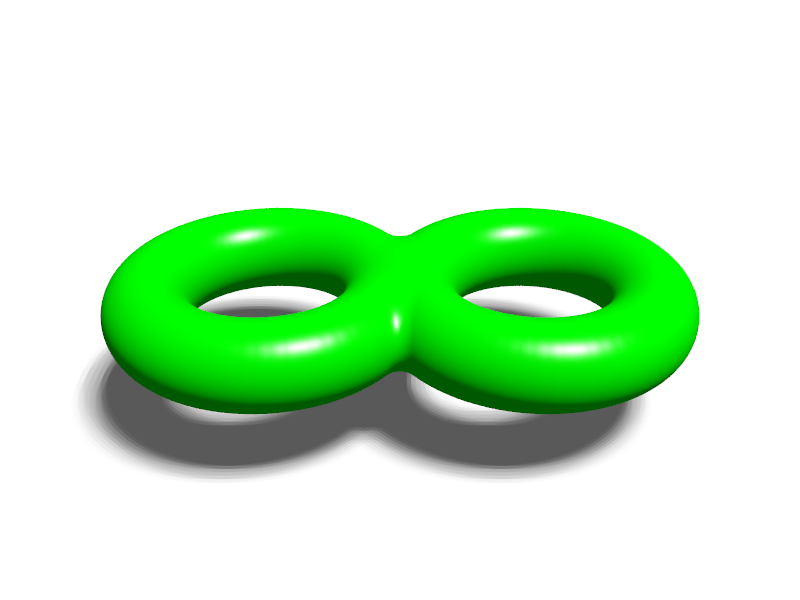
Remembering Maryam Mirzakhani

Maryam Mirzakhani
We were very sad to hear of the death of the brilliant mathematician Maryam Mirzakhani on 14 July at the age of 40. We were lucky enough to meet Mirzakhani at the International Congress of Mathematicians in Seoul in 2014, where she was awarded the Fields medal, the most prestigious prize in mathematics, for her work in geometry and dynamical systems. There were many demands on her at the conference, but she was generous with her time and it was a pleasure to hear about her work, her passion for mathematics and her thoughts on being awarded the Fields medal.
One of the many results Mirzakhani is famous for involves counting loops on mathematical surfaces. A familiar example of a mathematical surface is the surface of the Earth: although we know the Earth is (roughly) spherical, when we stand on the ground it seems flat. Another example is the surface of a donut, mathematically known as a torus. A mathematical surface is a shape which can be covered by little overlapping flat patches.
Mirzahani considered surfaces with a certain kind of geometry, known as hyperbolic surfaces. Given two points on the surface, the shortest path between these two points defined a special line on the surface called a geodesic. Planes follow similar geodesics defined by the spherical geometry of the Earth's surface, the flight paths follow a small section of a geodesic giving the shortest distance between the departure and arrival airports.

A torus with two holes.
Some geodesics are closed loops; that is, they end where they started. All geodesics on a surface with spherical geometry are closed, such as the lines of longitude and the equator on the Earth's surface. But geodesics can be more complicated for more complicated surfaces: for example if your surface is a two-holed torus (a donut with an extra hole), then such a closed geodesic might be a loop winding once around one of the holes.
One question you can ask is, given some length $L$, how many closed geodesics are there that have length $L$ or shorter? The longer the length $L$ the more closed geodesics of length less than or equal to $L$ you expect there to be, but how fast does this number grow? The answer, which has been known for over 50 years, is very neat. The number of closed geodesics of length less than or equal to $L$ grows exponentially with $L$, in fact, when $L$ is large it grows similarly to the expression $$e^L/L,$$

Spherical, hyperbolic and Euclidean (flat) surfaces (Image courtesy NASA.)
where $e = 2.71828...$ is a famous mathematical constant. (It's a kind of result that brings joy to any mathematician's heart, as it has an analogue in a completely different area of maths: it's very similar to the prime number theorem, which counts the number of primes less than or equal to some given number.)
One thing to notice about this result is that it doesn't depend on what type of hyperbolic surface you look at; in particular it doesn't depend on the number of holes it has. But Mirzakhani found that this changes if you count, not all closed geodesics, but only those that don't intersect themselves (for example, you ignore closed geodesics that look like figure eights). It turns out that then, the number whose length is less than or equal to $L$ grows much more slowly. Not exponentially, but like $$L^{6g-6},$$ where $g$ is the number of holes of the surface. It looks like a simple result but that's exactly what makes it special: results of such elegant simplicity that are nevertheless very hard to prove are a great prize in maths. And what is more, the insights she developed while proving this result led Mirzakhani to answering other open questions too. It's a very fruitful result. And as Mirzakhani herself said, "It's not only about the questions, but about the way you solve them."
Mirzakhani developed her childhood interest in maths during difficult times: during the war in Iran. "Those were hard times," she said, "but I was part of a lucky generation, as a teenager things became more stable." She moved to the United States to study for her PhD at Harvard University, and then became a professor at Princeton and Stanford universities. As well as being the first and, to date, only woman to be awarded the Fields Medal, she was also the first Iranian. Mirzakhani is an important reminder that mathematics doesn't care about who you are, where you are from, the language you speak, the colour of your skin, or your gender – it is a universal language that belongs to us all. It is a tragedy that we have lost such a brilliant mathematical mind so young.
You can read more about Maryam Mirzakhani's work and her Fields Medal in Maryam Mirzakhani: counting curves and Finally a female Fields Medallist.
Comments
Maziar esfahanian
Thanks for your article. But,What do you mean by Mirzakhani is an important reminder that mathematics does not care about who you are,where are you from and... . Sure she was a great woman and Iranian.you mean If she was from somewhere else in west , she was not an important reminder? I think in your unconscious you have a pre_judgment about my country and my copatriot or maybe consciously you want to induce your idea about Iranian to the people. Maryam Mirzakhani was a great mathematician and she was Iranian originally. She is a fields medalist as like as many other great mathematicians like Cedric Vilani ,Alen Cones and etc and if she is an important reminder for you all of other fields medalists are important reminder for us(Iranian).
Maryam Mirzakhani was a great mind and she is in our mind forever.
Anonymous
With reference to the comment above, I think the authors were referring to the fact that Prof. Mirzakhani was growing up during a time of conflict in Iran (mentioned in the Youtube video at the end of the article).
Hope that helps.